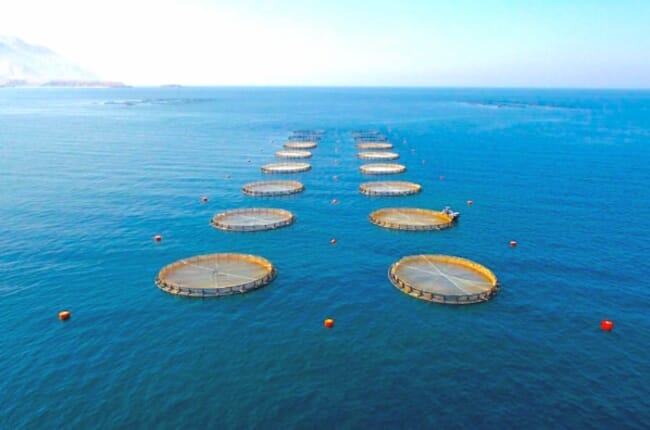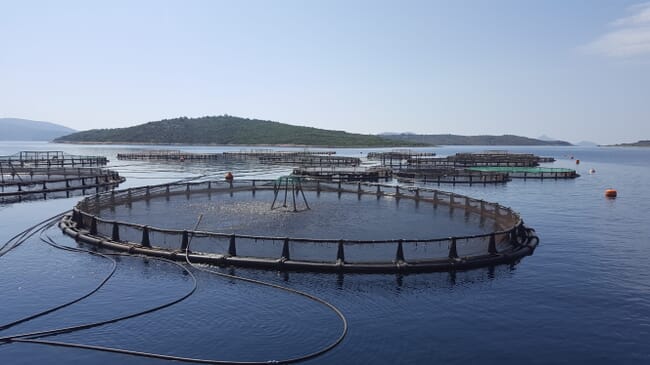
Though microplastics are becoming more prevalent in the environment, their presence has not been detected in the edible parts of farmed fish © Blue Waters
A study conducted by CTAQUA, the Technological Centre for Aquaculture and led by Juan Manuel García de Lomas, has analysed the presence of microplastics in fish from Spain’s aquaculture industry. Recent reporting has noted that microplastics, which are becoming more common in the natural environment, can be found in trace amounts in the digestive tract of fish, but no transfer to the edible parts of fish have been reported. The researchers made this observation after collecting data on water quality, aquafeed and farmed fish specimens from sites in Andalusia, the Canary Islands, Catalonia, the Valencian community, the Balearic Islands and the Murcia region.
Microplastics are becoming more prevalent in different habitats – mainly as a result of 20th and 21st century plastic pollution. Once discarded, plastics decompose into tiny particles – microplastics – that can spread through multiple ecosystems. These particles have been detected in the air, in soil and in bodies of water. Though 80 percent of microplastics come from terrestrial sources, they have been detected in freshwater and marine environments across the globe.
Spain’s aquaculture industry has taken a special interest in understanding and combatting microplastic pollution. The Spanish Aquaculture Business Association, APROMAR, has put its resources into innovation projects to help tackle the issue. One of these research projects has been carried out with the Technological Centre for Aquaculture (CTAQUA), an independent, non-profit foundation.

The researchers focused on sea bass, sea bream and turbot farms across Spain's coastal areas © Avramar
Projects/ACUIPLAS – Responsible aquaculture: microplastics
In 2019, CTAQUA partnered with APROMAR and launched its analysis on the presence of microplastics in Spain’s farmed fish, and the potential contamination of aquaculture species from this type of pollution. As stated by the lead researcher, "microplastics are an emerging anthropogenic pollutant, currently recognised as one of the most important – and continuously growing – environmental pollutants."
The researchers began by assessing the potential presence of microplastics in the edible parts of the fish and from there, hoped to analyse the origin of the plastic pollution. To do this, the researchers looked for microplastics with FTIR technology in three different matrices: fish fillets from aquaculture, the feed used and the samples of the waters adjacent to the aquaculture facilities.
The analysis were carried out on 15 batches, each of them made up of 10 individuals (150 fish in total) of the three main species of the study, sea bream, sea bass and turbot, as well as on the feed and in the waters where they were raised. Once the 150 fish in the sample had been filleted, in the same way that they are filleted for human consumption, they were processed and analysed. The study results found that, “no microplastic particles have been observed in any of the 150 fish samples analysed in this study.”
According to the managing director of CTAQUA, "the feed used to feed aquaculture animals may contain traces of these substances since they are manufactured from natural raw materials, which is why [microplastics can be detected] in the stomach and guts of fish, although in minimally detectable quantities. But these parts of the fish are always discarded, since they are consumed gutted, so there is no risk of microplastics reaching the consumer through this route. Consumers eat the muscle and skin of fish, and there have been no microplastics detected in these samples."
The ACUIPLAS study, the result of the joint work of APROMAR and CTAQUA, also examined the waters where aquaculture facilities are located. Like the rest of the enclaves scattered throughout the natural environment, these sites showed the presence of microplastics. However, these traces, although lower than other measurements made in other areas of the primary sector, did not contaminate the edible parts of the fish analysed. This confirmed that the presence of microplastics in waters where the fish are raised is not a vector for these materials to reach the consumer.




